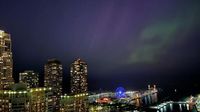As the stars align for an extraordinary celestial event, residents across the Midwest and Northeast are gearing up for a potential viewing of the Northern Lights late Tuesday night into early Wednesday morning. Thanks to a strong geomagnetic storm, the aurora borealis could illuminate the skies much farther south than usual, possibly reaching cities like Chicago and New York.
The National Oceanic and Atmospheric Administration’s (NOAA) Space Weather Prediction Center has issued a Geomagnetic Storm Warning for a "strong" G3 level event, which is significant on the G-scale that ranges from G1 to G5, with G5 being the most intense. This geomagnetic storm is the result of multiple magnetic eruptions from the Sun, known as coronal mass ejections, that are expected to impact Earth starting Tuesday, April 15, 2025.
Typically, the Northern Lights are a sight reserved for those living near the poles, but during strong solar storms, the phenomenon can extend southward. NOAA's warning indicates that if G3 conditions are reached, residents in mid-latitude regions, including Chicago and parts of the Northeast, could enjoy this natural light display late Tuesday night into early Wednesday morning.
In Chicago, the forecast looks promising, with mostly clear skies expected, setting the stage for an optimal viewing experience. However, the situation is more complicated for New Yorkers. Heavy cloud coverage is anticipated over much of the Northeast, including New York City, which may hinder visibility. According to meteorologists, a break in the clouds could allow for a glimpse of the auroras near the northern horizon, especially in less light-polluted areas outside the city.
Christopher Tate, a meteorologist at the FOX Forecast Center, suggests that the most vivid sights of the Northern Lights will occur over the Rockies and the Western U.S., just before sunrise. He emphasized the importance of finding a dark spot away from city lights for the best viewing experience. "The lights will show up better on camera, especially with a few seconds' exposure. But strong displays are still visible with just your eyes," he noted.
For those hoping to catch a glimpse of the aurora, experts offer a few tips: first, get away from city lights as light pollution can wash out all but the most intense auroras. Second, look north; the best view will be on the northern horizon, although stronger events may bring the lights higher in the sky. Third, be patient, as auroras can appear and disappear quickly. Finally, manage expectations; what you see in person may not match the vivid images often shared online, which are typically captured with long-exposure cameras.
In New Jersey, the potential for viewing the Northern Lights is also on the table. As forecasters monitor the magnetic energy that could elevate the storm to a higher level, the auroras may be visible as far south as New Jersey. Accuweather reported that if the geomagnetic storms are stronger than expected, the aurora could be visible even further south than initially predicted.
The current solar activity is part of the Sun's 11-year solar cycle, which is peaking in 2025. As solar activity increases, so does the likelihood of geomagnetic storms that can disrupt radio frequencies and satellite navigation systems. The NOAA has cautioned that the G3 storm could cause some satellite navigation problems, particularly as it transitions to a G1 level by Thursday, April 17, 2025.
As excitement builds for this rare opportunity to see the Northern Lights, many are reminded of last year's spectacular displays that captivated audiences across the region. The anticipation is palpable, with many residents eager to witness the beauty of the aurora borealis firsthand.
For those interested in learning more about the aurora and checking updates on the geomagnetic storm, resources are available on NOAA's Space Weather Prediction Center website and spaceweather.com. The best time for viewing is typically after sunset and before sunrise, making the late-night hours ideal for skywatching.
As the night approaches, the skies may hold a magical surprise for many. Whether in Chicago, New York, or New Jersey, the potential for witnessing the Northern Lights offers a thrilling glimpse into the wonders of our universe. Will the clouds part just in time for a dazzling display? Only time will tell, but for now, the excitement is building as people prepare for a night under the stars.







